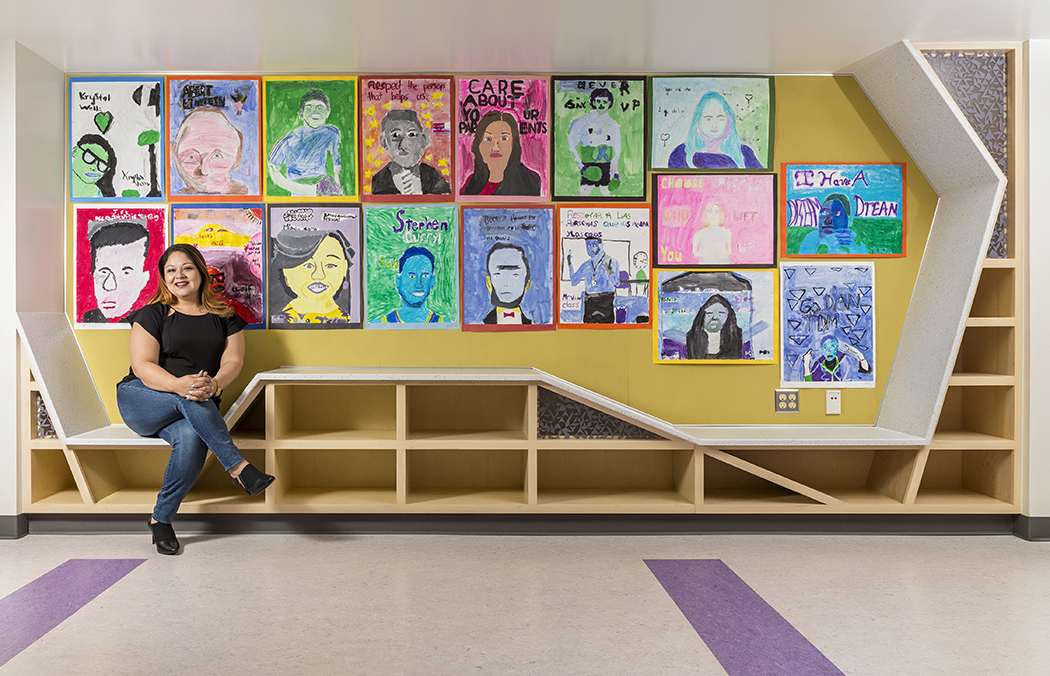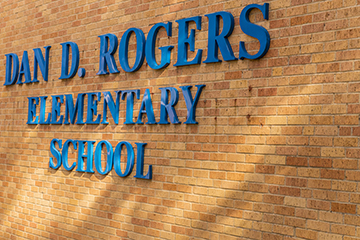
Lisa Lovato, Principal of the Year. (Photo by Danny Fulgencio)
Is Dan D. Rogers’ skyrocketing success enough to attract homeowners?
East Dallas has bragging rights to the best elementary school principal in Dallas ISD — Lisa Lovato of Dan D. Rogers — but only a tiny fraction of homeowners in the surrounding neighborhoods send their children to the school.
Instead, parents are sending their children to private, charter or other district schools, such as Robert E. Lee and Dealey Montessori. Only 7.7 percent of Rogers’ 518 students live in Ridgewood Park, University Meadows, Fisher Heights or North Hill homes and condos.
“I don’t even have the opportunity to make an impact on the kids who never gave us a chance,” Lovato says.
Lovato has spent the past six years navigating the shifting culture of the school, the changing demographics of the neighborhood and, most recently, the transition to a DISD “school of choice” in 2015. That’s when the school switched to a personalized learning curriculum approach, and subsequently, her students’ success skyrocketed. This past year, Rogers received all possible distinctions from the Texas Education Agency, meaning it performed better on mandated STAAR exams than peer campuses with similar demographics. The elementary school was one of 17 DISD schools that received this honor, and one of only eight non-magnet schools.
DISD recognized Lovato’s success and community-driven approach in December, when she received the Principal of the Year award, given to one campus leader at a district elementary, secondary and magnet school, respectively. It’s an even higher honor considering that there are 151 DISD elementary schools.
Rogers is thriving, but neighborhood families are just starting to take notice.
“There’s an assumption that DISD schools aren’t up to the same standard as private schools,” says Jack Courtney, a Rogers mentor and alumnus. “DISD is going to have to overcome that assumption.”
In 2010, right before Lovato’s arrival, many homeowners felt sending their children to the elementary school simply was not an option. A Ridgewood Park Neighborhood Association subcommittee requested to add its 400 homes to the Lakewood Elementary attendance zone, which is full of homeowner parents who believed in their neighborhood public school.
The request quickly became moot, as the DISD Board of Trustees pulled it from the agenda before it was ever discussed. But the failed merger highlighted two major differences between the elementary schools: Rogers’ student body was predominately Hispanic, black and poor, while Lakewood’s was white and affluent. Rogers’ standardized test scores in math, reading, writing and science also were significantly lower than the likes of Lakewood or Stonewall Jackson.
Parents insisted that the obvious racial and socioeconomic differences were irrelevant and that the campus’ low achievement was cause for concern.
Lovato became principal a year later, her first time with the lofty job title. Her résumé included seven years as a teacher before serving as assistant principal of Casa View and Truett elementaries, both high-poverty schools in Far East Dallas. Before Lovato took the helm, Rogers lacked the camaraderie it has now, and staff weren’t encouraged to take risks, says Marissa Limon, who was a teacher before becoming the school’s personalized learning coordinator. Teachers used a traditional approach in which children are taught in a group setting, and students without the confidence to ask for help tended to fall behind.
“How are we going to achieve if we’re teaching to the middle, but not addressing the high or low?” Lovato says.

(Photo by Danny Fulgencio)
The personalized learning curriculum, with similarities to the Montessori approach, has helped bridge the achievement gap because all students learn at their own pace. Lovato also has paid close attention to the hiring process. Choosing a diverse staff who can relate to students has been essential to Rogers’ success, she says.
Rogers’ student body currently is 13.9 percent black, 66.3 percent Hispanic and 15.6 percent white. Roughly 14 percent are immigrants, and 71 percent of students are economically disadvantaged. That’s a shift since 2010, when 92 percent of the school was economically disadvantaged.
The renovation of nearby apartments also has impacted the school, which lost 100 students because of gentrification. Many landlords hope to entice young professionals instead of low-income families, Lovato notes. The transition makes it difficult to project the school’s enrollment.
Cultural differences can deter homeowners from sending their children to Rogers, Lovato says. Twenty-one languages are spoken at the school, and parents sometimes are concerned about how it might impact their child’s education, even though personalized learning is designed to address those differences.
Ridgewood Park homeowner Kristy Ladner believes diversity is beneficial, but Lovato’s enthusiasm about the curriculum was what attracted her to the school, she says. Her son will enter the school as a kindergartner this coming fall.
“I felt that it would be positive for my child, regardless of what the socioeconomic status was of other children in the school, regardless of what other students were capable of or were not capable of,” she says. “It wouldn’t be a concern because of the rigors they have in place.”
Ladner founded the Rogers Early Childhood PTA to encourage neighborhood families to meet and learn about the school at monthly events. Families with toddlers have shown interest in Rogers, but those with children already attending private schools, such as Zion Lutheran School, don’t want to leave a familiar environment, she says.
The parents she’s spoken with aren’t as concerned with language barriers as they are with the number of students transferring into the school. The 518-student school has 137 transfers, nearly half of them from Hotchkiss and Jill Stone elementaries in the refugee-inhabited Vickery Meadow area.
“With all of the transfer students, there’s that concern, ‘Are my child’s friends going to be nearby or will it be harder to have those social relationships?’ ” Ladner says.
University Meadows homeowner Wynne McNabb Cunningham hasn’t decided where she’ll send her 5-year-old son to kindergarten yet, although Rogers is in the running. He didn’t qualify for DISD’s prekindergarten program, so he’s currently enrolled at Zion Lutheran.
“We would definitely consider a public school. Quality public school is vital in righting some of the institutional wrongs in our society,” she says.
Many of her neighbors purchased their homes specifically to attend a nearby private school.
“There are a lot of people who move to the neighborhood, because it’s so close to private schools that are renowned,” she says. “Because it doesn’t feed into Lakewood with traditionally higher scores, homeowner values are a bit lower.”
Lovato has tried to engage neighborhood families through open houses and tours, but Rogers is willing to teach any student willing to put in the effort, she says. Her “infectious enthusiasm” and determination are what impresses Courtney the most. He hopes that positivity will become more apparent in the neighborhood, but it won’t happen overnight.
“We as alumni need to do more than what we’ve done, DISD needs to do more than what they’ve done, and then hopefully we’re where we need to be,” he says.





